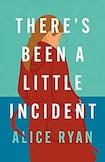
In There’s Been a Little Incident, the debut novel by Irish writer Alice Ryan, the “incident” in question is the disappearance of Molly, a young woman with a history of going missing. As Molly is an only child whose parents had died by the time she was 18, it falls to an extended cast of friends and relatives to get on the case. It becomes clear from early on, however, that this is not going to be a grim missing-person novel, but rather an extended exploration of the binding force of shared grief and personal history. It is about those who are there for you, even when you are not there yourself.
At more than 400 pages long, and with a family tree of 19 characters (with more to come), there is a sense of the reader buckling in for something epic. The opening chapter involves a chaotic meeting where the extended family squeezes into a room together to figure out how to find Molly. We get a flurry of introductions: Cousin Bobby (“a tall strapping former rugby player”), Aunt Frances (a former TV crime expert who “updated you on her aura”), Aunt Angela (who had “drunk a pulpit of holy-water-flavoured Kool-Aid”), two young cousins named Damon and Liam, known as Blur and Oasis – not to mention others such as Granny, Lady V, Uncle Mike, Uncle John. As an opening, it’s a little overwhelming.
The novel is structured into separate chapters for each of the main characters, with a heavy emphasis on backstory. Here we get a second shot at the introductions through more detailed character profiles that flip back and forth through time. It is noticeable that the younger characters are afforded a degree of depth and interiority, whereas older characters tend to lapse into sitcom caricature. Young Bobby, for example, is painted with tenderness as a former school rugby star still struggling with the unresolved grief over the death of his schoolfriend, and possibly first love, Jack. In contrast, Uncle Mike carries a half-eaten sausage around with him and Uncle John is in a feud with a neighbour over the correct use of recycling bins.
Overall though, you get the sense that Ryan cares about her characters. The gentle notes of humour are not intended to undermine them but to inject a little levity – “People said that Molly’s zeal for life was infectious. But Anne hated infections.” The book is also full of attentive details: “People thought that Sheena was tall but on second glance she was just athletic.”
Pancake Tuesday: The only recipe you need for making an easy, better batter
My elderly mother’s health is declining quickly. Should we prepare her home for sale?
‘Where I come from, people don’t do medicine. It’s not on your radar’: how a new generation of doctors is being trained
Pancake Tuesday: What’s the history, what does ‘shrove’ mean and what’s the significance for single people?
The structure of this novel is not unusual for contemporary fiction – multiple strands of narrative, shifting time periods – but for this approach to work, a degree of editorial discipline is needed. It’s hard to keep the reader engaged by lengthy backstories about characters who have yet to do enough to earn our interest; and there is a limit to how many characters and timelines a reader can follow and care about at once. The editing at sentence level needed to be tighter too. The writing is free-flowing and natural but let down by an overuse of familiar phrases: “spanner in the works”, “thick as thieves”, “wild goose chase”, “watching her like a hawk”.
The recurring theme for these characters is the tidal pull and release of grief in their lives. It is something that they navigate alone and with those who matter most. While the novel’s many narrative tributaries don’t ultimately join to form a single flow, there are poignant vignettes in the final third where we get a glimpse of the book’s true heart.
There is plenty to admire in Alice Ryan’s debut. Its careful and sensitive rendering of an ensemble cast of characters shows perspicacity and observational skill. She is clearly ambitious when it comes to structure and is not afraid to challenge herself. She’s good on mood too: the story rolls gently along alternating waves of melancholy and humour, with the tricky transitions between them handled well.
As debuts go, perhaps this reminded me a bit of Zadie Smith’s White Teeth – fizzing with ideas about a constellation of characters, where the writer wants us to know and understand everything about them and their world. But this also becomes the book’s main vulnerability. There is a danger that when you’re good at something, you do too much of it. Pairing the writer’s talent with more disciplined editing would have helped to bring out the book’s undoubted strengths and cut away the clutter.
Ronán Hession’s latest novel is Panenka














